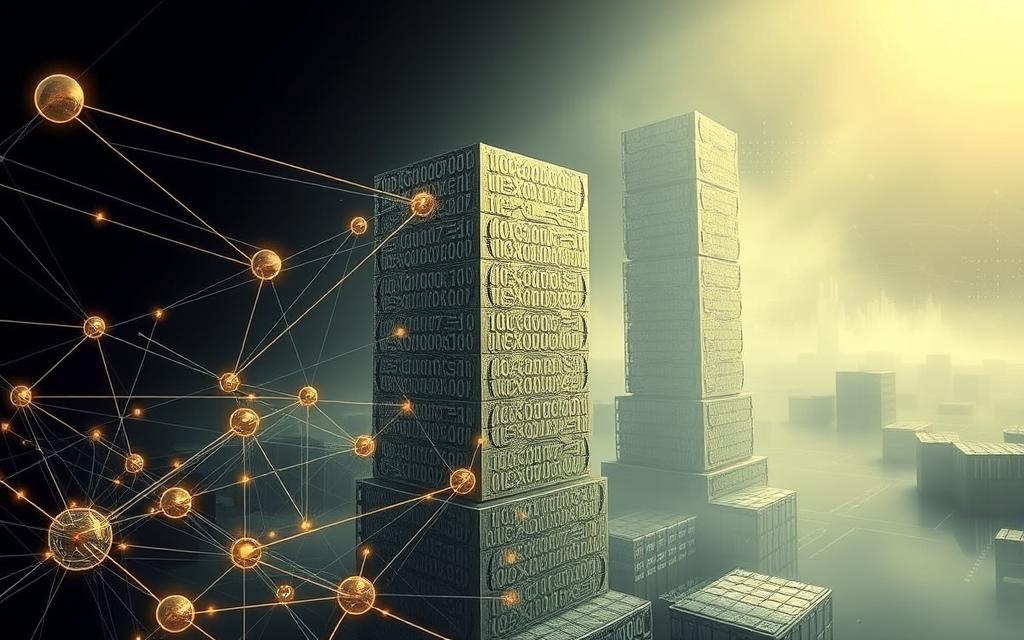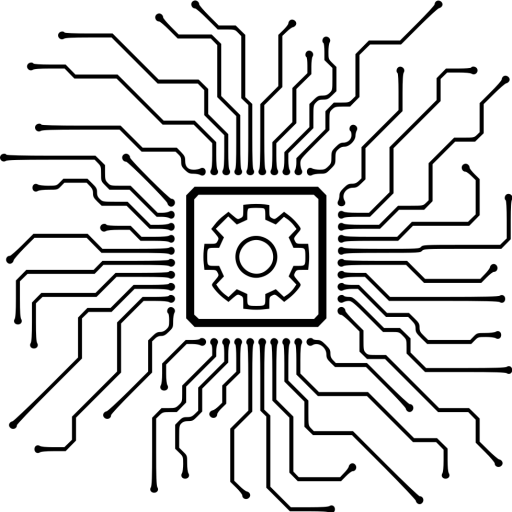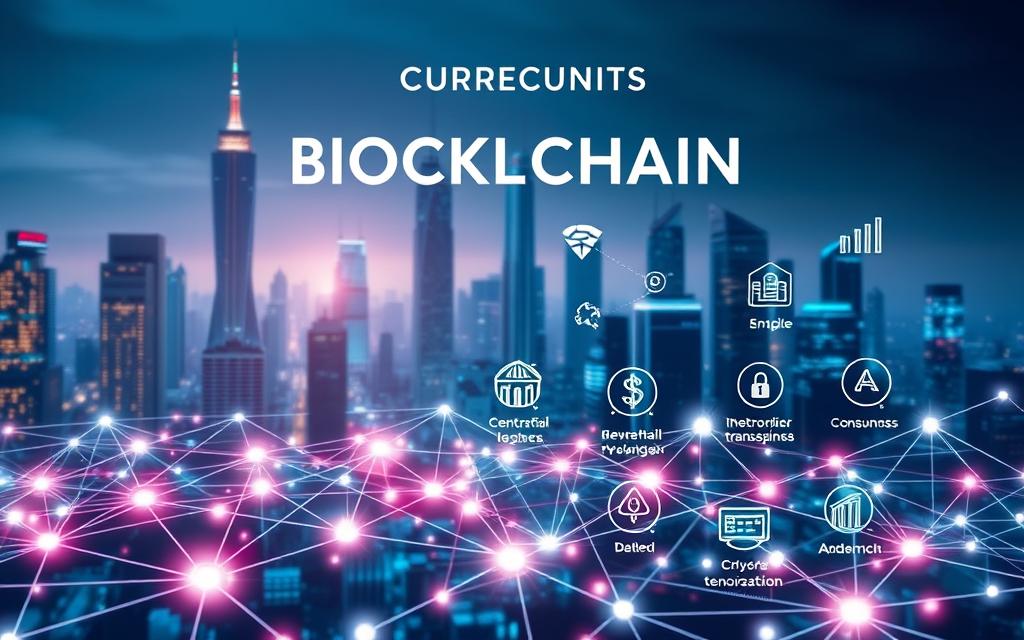Imagine a digital ledger that everyone can access at the same time. Yet, no one can change it. This idea is at the heart of distributed ledger technology.
This technology was born out of the 2008 financial crisis. Satoshi Nakamoto’s Bitcoin whitepaper introduced it. It’s a big change in how we keep track of and check transactions.
The system works by linking blocks of data in a timeline. Each new block adds to the previous ones. This makes a permanent record that’s hard to change.
This network doesn’t need middlemen. Transactions happen directly between people. They are recorded openly for everyone to see.
In our beginner’s guide to blockchain, we’ll cover the basics. You’ll learn how this technology works in real life.
Understanding Blockchain Fundamentals
Before we explore how blockchain works, let’s understand its basics. This knowledge will show why blockchain is a big change from old data systems.
What is Blockchain Technology?
Simply put, blockchain is a shared database on a network of computers. The EU Blockchain Observatory calls it “a tamper-proof, shared digital ledger.” It records transactions safely and openly.
Unlike old databases, blockchain uses many computers together. Each computer has the whole ledger. This means no one person controls everything.
This tech is key for digital money like Bitcoin. But it’s used for more than just money. It’s for any system where many people need to trust the same data without needing a middleman.
Key Characteristics of Distributed Ledgers
Blockchain stands out because of its unique features:
- Decentralisation: It avoids single points of failure by spreading control among network users
- Transparency: All transactions are visible, making it easy to check the record
- Immutability: Data can’t be changed or deleted once it’s recorded, keeping records safe
- Security: It uses cryptography to protect data and stop unauthorized changes
These features help create systems that don’t need a central boss. Everyone can check transactions themselves. And because records can’t be changed, they stay trustworthy over time.
How Blockchain Differs from Traditional Databases
Blockchain is a big change from how we used to manage data. Old databases are controlled by one person or group. They decide what happens to transactions.
Investopedia says blockchain doesn’t need these middlemen. Instead, it uses a system where everyone agrees on what’s true.
This change makes blockchain different in many ways:
| Aspect | Traditional Databases | Blockchain |
|---|---|---|
| Control Structure | Centralised authority | Distributed network |
| Verification Process | Central administrator | Consensus mechanisms |
| Data Integrity | Trust-based | Cryptographically guaranteed |
| Accessibility | Permissioned access | Varies (public/private) |
For example, when you send money through a bank, the bank checks it. With blockchain, many computers agree on transactions. This means no middleman is needed.
This change lets new kinds of systems work together. They can do so without needing to trust each other. Blockchain builds trust through math and agreement, not just reputation.
The Technical Mechanics Behind Blockchain
Blockchain’s technical side is what makes it truly special. It uses advanced systems to create a secure, open, and decentralised network. This network changes how we handle digital transactions and manage data.

Cryptography and Hash Functions
At the core of blockchain’s security is blockchain cryptography. It keeps data safe and stops tampering. Hash functions act like digital fingerprints, turning any data into a fixed-size string.
These algorithms have key properties:
- Deterministic – same input always produces identical output
- Quick computation – outputs generate rapidly
- Pre-image resistance – output cannot reveal original input
- Avalanche effect – minor input changes create completely different outputs
Each block has its hash and the previous block’s hash. This makes the chain unbreakable. Changing one block would require recalculating all others.
Consensus Mechanisms: Proof of Work vs Proof of Stake
Blockchain networks agree on transaction validity through consensus mechanisms. There are two main systems, each with its own approach to security and validation.
Proof of work consensus uses computational power to validate transactions and create new blocks. Miners compete to solve puzzles, with the first miner adding the next block and earning rewards.
This system is secure but uses a lot of energy. The competitive nature of mining keeps the network safe, as attacking it would need overwhelming power.
Proof of stake is an energy-efficient alternative. Validators are chosen based on the cryptocurrency they “stake” or lock up. This system:
- Reduces energy consumption by approximately 99%
- Increases transaction processing speed
- Lowers barriers to participation
- Maintains security through economic incentives
Both systems keep the network decentralised but focus on different things – security versus efficiency and sustainability.
Smart Contracts and Their Functionality
Smart contracts explained show how they are a game-changer. These self-executing agreements automatically enforce terms when conditions are met. They cut out intermediaries and reduce errors.
Smart contracts use “if-then” logic programmed into code. For example, a shipping contract might automatically release payment when GPS confirms delivery.
Smart contracts have many benefits:
- Automation of contractual obligations
- Transparent execution visible to all parties
- Reduced transaction costs by removing intermediaries
- Enhanced security through cryptographic protection
- Immutable terms that cannot be altered once deployed
These contracts are used in many areas, not just cryptocurrency. They power supply chain management, insurance claims, and royalty distribution. Their programmable nature makes complex business logic possible with blockchain’s security.
Understanding these technical parts shows why blockchain is a big deal. It combines cryptography, decentralised consensus, and programmable contracts. This creates a foundation for trustless digital interactions that were once impossible.
How to Use Blockchain Technology: Practical Steps
Now you know the basics of blockchain technology. Let’s dive into the practical steps to start using it. This guide will help you on your first blockchain journey.
Setting Up a Digital Wallet
First, you need to set up a digital wallet. This software keeps your cryptocurrencies safe and connects to blockchain networks. You can pick between hot wallets (online) and cold wallets (offline).
Here’s how to create a wallet:
- Download a trusted wallet app
- Make your unique wallet address
- Keep your recovery phrase safe offline
- Add extra security features
Your private keys are your secret. Never share them with anyone.
Acquiring Your First Cryptocurrency
To buy cryptocurrency, start by picking a reliable exchange. Look at security, fees, and the types of coins available.
Most exchanges work like this:
- Make an account and verify your email
- Do identity checks (KYC)
- Link your payment method
- Make your first purchase
Begin with small amounts to learn the platform. Different payment methods can change how fast transactions are processed.
Executing Your First Blockchain Transaction
Sending cryptocurrency is easy. You need the recipient’s wallet address and how much to send.
Follow these steps carefully:
- Open your wallet’s send function
- Paste the recipient’s address correctly
- Check the address before confirming
- Look over the transaction details
- Confirm the transaction
Blockchain transactions can’t be undone. Always check the address before sending.
Understanding Transaction Fees and Confirmation Times
Blockchain networks charge fees for transactions. These fees pay network validators for their work.
Several things affect fees and how long transactions take:
- How busy the network is
- How complex the transaction is
- How fast you want it done
- The type of blockchain network
Bitcoin uses miner fees, while Ethereum uses gas fees. You can often choose between speed or cost.
Confirmation times vary a lot. Some transactions are done in seconds, while others take minutes or hours.
Common Blockchain Applications and Use Cases
Blockchain technology is more than just digital currencies. It’s changing many industries with its unique features. It makes systems more open, efficient, and safe.

Cryptocurrencies: Bitcoin and Ethereum
Bitcoin showed us digital money without a central bank. It’s a system where people can send money directly to each other. Its blockchain keeps track of all transactions, making sure money isn’t spent twice.
Ethereum took it further by adding smart contracts. This lets developers create apps that work on their own, without needing someone in the middle. Ethereum’s blockchain is now the base for many new ideas.
Supply Chain Management Solutions
Blockchain makes supply chains more open by keeping a record of products. Companies like IBM use it to track food from farm to table.
This tech stops fraud and makes sure products are real. It also makes things more efficient. Everyone in the supply chain can check where products come from and how they’ve been handled.
Digital Identity Verification Systems
Blockchain lets people control their own digital identities. They don’t have to rely on others to manage their data.
These systems let people share information on their own terms. This reduces the risk of data breaches. Companies can check identities without keeping personal data, keeping everyone safe and in line with privacy laws.
Decentralised Finance (DeFi) Platforms
DeFi platforms are changing finance by removing middlemen. They offer lending, borrowing, and trading through smart contracts, not banks.
Some top DeFi platforms are:
- Compound – algorithmic money markets
- Uniswap – decentralised exchange protocol
- Aave – open-source liquidity protocol
These platforms let anyone with internet access use financial services. They often give better returns than banks and are transparent because everything happens on the blockchain.
Security Best Practices for Blockchain Users
Blockchain’s decentralised nature means users must take on more security responsibility. Unlike traditional banking, blockchain security relies heavily on individual practices. Here are key steps to protect your blockchain assets.
Protecting Private Keys and Recovery Phrases
Your private keys and recovery phrases are like the keys to a safe deposit box. Treat them with the utmost care. Private key protection means keeping them safe, not memorising them.
Here are some secure storage options:
- Hardware wallets: Physical devices that store keys offline, immune to online hacking attempts
- Encrypted digital storage: Password-protected files on encrypted drives or USBs
- Physical mediums: Written on durable, fire-resistant materials stored in secure locations
Never store recovery phrases digitally in plain text formats like email, cloud storage, or screenshots. Keep multiple backups in different secure locations to protect against physical damage or loss.
Recognising and Avoiding Common Scams
The cryptocurrency space attracts many bad actors. Avoiding crypto scams means being cautious of offers that seem too good to be true. They usually are.
Common scam types include:
- Phishing attacks: Fake websites mimicking legitimate exchanges to steal login credentials
- Fake investment schemes: Promises of guaranteed high returns with little risk
- Impersonation scams: Fraudsters posing as customer support or known figures in the space
- Social engineering: Manipulative tactics to gain your trust and access to your assets
Always verify website URLs, double-check addresses before sending funds, and be wary of unsolicited investment opportunities. Legitimate organisations will never ask for your private keys or recovery phrases.
Choosing Reputable Exchanges and Wallets
Your choice of service providers greatly affects your blockchain security. Do thorough research before trusting any platform with your funds or personal information.
Consider these factors:
- Regulatory compliance: Proper licensing in jurisdictions where they operate
- Security history: Transparent reporting of past incidents and responses
- Insurance coverage: Protection for assets held on their platform
- Community reputation: Long-standing positive presence and user reviews
Choose established platforms with a proven track record for better security. Look for exchanges that use cold storage for most customer funds and have strong security protocols.
Implementing Two-Factor Authentication
Two-factor authentication (2FA) adds a critical layer of protection. It requires two different types of evidence before granting access to your accounts.
Here are some options:
- Authenticator apps: Generate time-based codes on your mobile device (more secure)
- SMS verification: Codes sent via text message (convenient but less secure)
- Hardware security keys: Physical devices that must be present to authenticate
When setting up 2FA, make sure to:
- Secure your backup codes in multiple locations
- Use different authentication methods for different accounts
- Regularly review and update your 2FA settings
- Test recovery procedures to ensure you can regain access if needed
Remember, 2FA enhances security but doesn’t replace other measures. Use multiple security layers for complete private key protection and account safety.
Conclusion
Blockchain technology is changing how we use systems from centralised to decentralised. It brings transparency, immutability, and security. This guide has shown how to start using blockchain, from setting up a digital wallet to making secure transactions.
The future of blockchain includes new trends like Web3, NFTs, and digital currencies from central banks. These will change how we interact online and manage money. To use blockchain, you need to know what it can do and its limits.
But, there are challenges like making blockchain work for more people, its energy use, and unclear rules. Despite these, blockchain is being used more in areas like supply chains, digital identity, and finance.
It’s important to keep learning and be careful as blockchain evolves. It’s a big tech change with real uses. Its impact on digital systems will be felt for many years.







